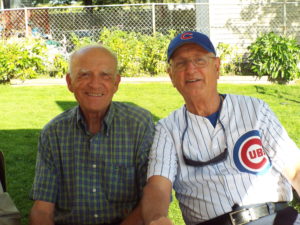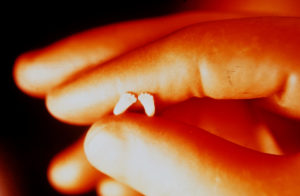KAREN MAHONEY
SPECIAL TO THE CATHOLIC HERALD
 Nearly 50 years after pulling tiny, perfectly formed bodies of aborted babies from a formalin-laden bucket, Dr. Russell Sacco, 83, an Oregon urologist and founding member of Oregon Right to Life, has died of cancer. He is survived by Elizabeth, his wife of 58 years, four children and eight grandchildren.
Nearly 50 years after pulling tiny, perfectly formed bodies of aborted babies from a formalin-laden bucket, Dr. Russell Sacco, 83, an Oregon urologist and founding member of Oregon Right to Life, has died of cancer. He is survived by Elizabeth, his wife of 58 years, four children and eight grandchildren.
The Kenosha native and UW-Madison Medical School graduate received worldwide recognition for photographing the tiny feet of an aborted baby.
In 1970, Sacco was curious as to the allegations of abortionists who said an unborn baby was just a “blob of protoplasm.” As a practicing Catholic, he knew that human life began at conception, but had no medical training about fetal development, so, he began studying human embryology to prove that those in the abortion industry were wrong.
One afternoon, Sacco was visiting a fellow doctor in a Portland hospital. The pathologist was responsible for destroying the bodies of babies following abortions. Not wanting to destroy the tiny bodies, as he was supposed to do, the pro-life pathologist had kept vats of aborted remains on a shelf in his office.
“I stuck my hand in and one by one held about five or six of these little bodies and realized that not one of them were more than five months gestation,” Sacco said in an interview with the Catholic Herald five years ago. “It was so awful and I felt that the only way I could explain to people about the reality of abortion was to photograph them, so I asked if I could take the bucket home and take pictures and prepare some slides and go out and give speeches.”
At home, he photographed each of the babies, but Sacco soon realized that the public would never know the size of the babies without some comparison. So, he held the babies between his gloved fingers and took some pictures.
 “All of a sudden, I saw these tiny feet; these perfectly formed tiny feet, with little toes, little wrinkles and creases and I held them between my fingers and took the picture. I was crying because I felt so bad — it just really got to me,” he said. “I really didn’t think the photo would be anything, but God must have taken the picture because it was perfect, and I knew that this would be one powerful way to send a message to the world, as this unborn baby was only about 10 weeks along.”
“All of a sudden, I saw these tiny feet; these perfectly formed tiny feet, with little toes, little wrinkles and creases and I held them between my fingers and took the picture. I was crying because I felt so bad — it just really got to me,” he said. “I really didn’t think the photo would be anything, but God must have taken the picture because it was perfect, and I knew that this would be one powerful way to send a message to the world, as this unborn baby was only about 10 weeks along.”
Sacco presented the photos to schools, groups, commercial areas and spoke on television and radio to spread the pro-life message.
His photos began making their way around the world and one day he received a call from Australia asking to use it to spread the word about abortion. The photos were copied and used among many pro-life groups.
In January 1974, as pro-lifers were planning a march in Washington to commemorate the first anniversary of Roe v. Wade, Virginia Evers carefully modeled the iconic “Precious Feet” pins after seeing Sacco’s picture in the newspaper.
To date, more than 20 million Precious Feet pins have been distributed worldwide. They are the international symbol of pro-life.
Dan Miller, State Director of Pro-Life Wisconsin never leaves the house without wearing his pin.
“They are that impactful,” he said. “Dr. Russell Sacco’s legacy to end abortion will live on through the Precious Feet pins you see on the lapels of pro-lifers all over the world. These tiny feet have started more conversations about the humanity and dignity of the human person more than anything I’ve ever seen in my struggle to end abortion in Wisconsin. We walk on the shoulders of those that have gone before us, but this Wisconsin native has made that fight so much easier because of his vision. My prayers go out for him and all his loved ones.”
Sacco was convinced that if people know what the unborn looked like, they would reconsider their position on abortion explained Lois Anderson, Executive Director, ORTL.
“He inspired one of the most effective and ubiquitous pro-life tools we have,” she said. “He inspired us to use science to show truth. This is especially important in Oregon, where we have a low percentage of people who attend church or claim a faith at all. He showed us the power of a symbol that can begin conversations that change minds.”
Sacco’s great nephew, Benjamin Kramer, a Kenosha resident and Ave Maria College senior, has fond memories of his uncle showing him magic tricks when he was a young boy. He learned of his uncle’s contributions when he was in high school.
“I had seen the tiny feet campaign and picture all over but didn’t know it was my great uncle who initiated it,” he said. “It was a bit shocking and I felt proud of him. He did so much good for the world and it hit so close home. He was a humble guy and didn’t speak a lot about what he had done.”
A communications major, Kramer hopes to attend law school and become politically active with the hope of passing pro-life legislation.
“He could only do so much, but maybe if I become a politician, I can continue his work,” he said. “His work has propelled me into pro-life ministry. Everything I am doing stems from my uncle’s work.”
